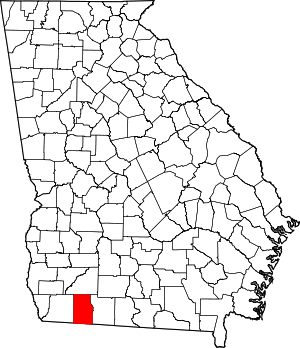Lower Muskogee Creek Tribe (East of the Mississippi)
The Lower Muskogee Creek Tribe is a state-recognized heritage group located in Southwest Georgia. It is not part of, associated with, or acknowledged by the Muscogee (Creek) Nation - a federally-recognized tribe that was removed from Georgia and Alabama in the 1820s and 1830s during Andrew Jackson's ethnic cleansing campaign. The heritage group maintains the Tama Tribal Town on a small tract of land in Whigham, Georgia. The group leadership offers regular educational classes to members and the public to learn more about Muskogee culture and language.
On January 27, 1825, the Indian Removal Act was signed, calling for the removal of all Native American Tribes in Georgia. In the following years, most of the Muskogee people were forcibly relocated to Oklahoma. Those who stayed hid in swampy, less desirable areas; fled to Florida and joined the Seminole tribe; or moved frequently to avoid capture. Laws limiting the rights of the Muskogee people were not officially removed until 1980.[1]
While it is not under the purview or authority of states to recognize tribes - Georgia adopted a "Resolution Recognizing the Lower Muskogee Creek Tribe" on March 16, 1973. It read, in part:
... NOW, THEREFORE, BE IT RESOLVED BY THE SENATE that this body hereby recognizes the Muskogee-Creek Indian Tribe East of the Mississippi River in the State of Georgia as a tribe of people ...
Proclamations recognizing the Creeks as a tribe have been made by recent Georgia Governors, including Jimmy Carter, Joe Frank Harris and Zell Miller.[2]
The Georgia Commission of Indian Affairs was formed by Executive Order on May 9, 1977. The Order provided for the appointment of the members of the Commission, and recognized the Lower Muskogee Creek Tribe-East of the Mississippi, Inc. as a legal entity.
In December 1981, the Bureau of Indian Affairs (BIA) denied Lower Muskogee Creek Tribe federal recognition as published in the Federal Register due to: "(1) The unstable membership which shows great fluctuations in size and composition; (2) the lack of historical data for most geographic areas and for many time periods, and the concurrent lack of evidence of political continuity; (3) the apparent recent institution of "clan" organizations; and (4) the lack of historical connections or association between families that would be expected from the asserted historical tribal character. The conclusions regarding the limited historical identification of the group as Indian and the lack of proven Creek ancestry for a large part of the group's membership were either not addressed or were answered by restating earlier arguments. Some of the factual conclusions in themselves were sufficient to deny tribal status to the group but collectively they were overwhelmingly against the LMC assertion that they were a tribe."[3]
References
- "Historical Overview of the Lower Muskogee Creek Tribe". home.rose.net. Archived from the original on April 25, 2005. Retrieved July 24, 2017.
- "Archived copy". Archived from the original on 2008-07-17. Retrieved 2010-05-14.CS1 maint: archived copy as title (link)
- "Final determination that the lower Muskogee Creek Tribe-East of the Mississippi, Inc., does not exist as an Indian tribe" (PDF). Bureau of Indian Affairs. October 21, 1981. Archived from the original (PDF) on October 2, 2012. Retrieved July 24, 2017.
